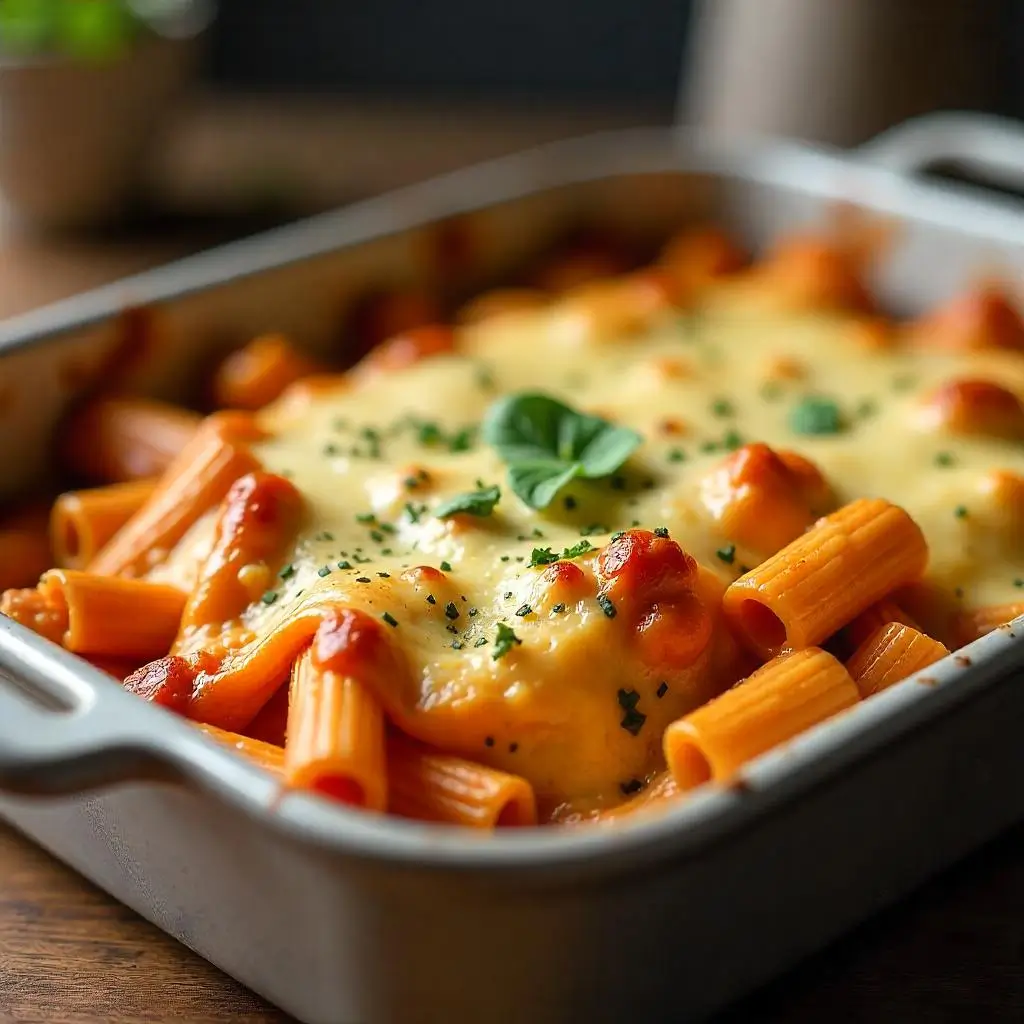When it comes to comfort food that brings the whole family together, nothing beats a perfectly baked ziti. Furthermore, this incredible pasta dish transforms simple ingredients into something truly magical. Whether you’re planning a cozy weeknight dinner or preparing meals for the week ahead, this fantastic pasta bake delivers both flavor and convenience in every single bite.
Moreover, what makes this recipe particularly special is its versatility and generous portion size. In fact, you’ll have plenty of delicious leftovers that taste even better the next day. Additionally, the combination of creamy ricotta, melted mozzarella, and tangy marinara sauce creates layers of flavor that will have everyone asking for seconds.

1Table of content :
- Essential Ingredients for Perfect Meatless Baked Ziti
- Step-by-Step Guide to Baked Ziti Perfection
- Variations and Customization Ideas :
- Pro Tips for Perfect Baked Ziti Every Time
- Nutrition Information Per Serving
- Storage and Reheating: Making the Most of Your Leftovers
- Perfect Pairings: What to Serve Alongside Your Baked Ziti
- Frequently Asked Questions About Baked Ziti
- Baked Ziti vs Lasagna: Understanding the Delicious Difference
- Other recipe
Essential Ingredients for Perfect Meatless Baked Ziti
Creating this amazing dish requires just a handful of quality ingredients. Most importantly, each component plays a crucial role in building those incredible layers of flavor.
Ziti Pasta (16 oz): First, you’ll need a full pound of ziti pasta, though you can easily substitute with rigatoni or penne if needed. Additionally, gluten-free pasta works wonderfully for those with dietary restrictions. The tube shape of ziti perfectly captures the creamy cheese mixture, ensuring every bite is absolutely delicious.
Ricotta Cheese (24 oz): Without a doubt, ricotta is the star of this show. Alternatively, you can make homemade ricotta in under 30 minutes for an extra special touch. However, if ricotta isn’t available, cottage cheese, sour cream, mascarpone, or cream cheese can work as substitutes, though each will create slightly different flavors and textures.
Large Egg (1): Next, a lightly beaten egg helps bind the cheese mixture together. Nevertheless, you can omit this ingredient or use a vegan substitute like flax egg if needed.
Parmesan Cheese (½ cup plus extra): Meanwhile, freshly grated parmesan adds that sharp, nutty flavor that elevates the entire dish. Similarly, pecorino romano can substitute if you prefer a slightly saltier taste.
Mozzarella Cheese (16 oz): Subsequently, you’ll divide this between mixing into the base and topping the casserole. Notably, grating your own mozzarella produces better melting results than pre-shredded varieties.
Spaghetti Sauce (32 oz): Finally, a flavorful jarred sauce saves significant preparation time. Specifically, choosing a well-seasoned variety means less additional seasoning needed later.
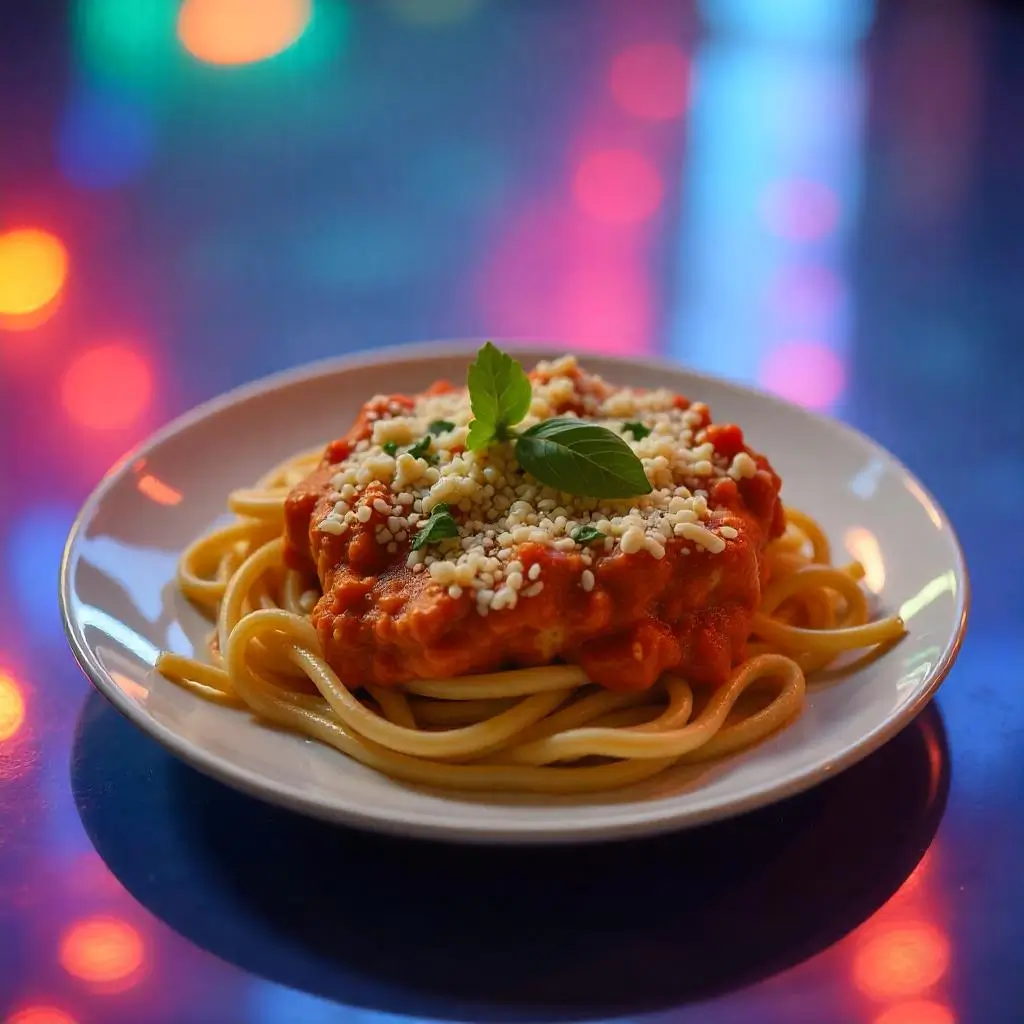
Step-by-Step Guide to Baked Ziti Perfection
Creating this masterpiece involves five simple yet important steps that ensure perfect results every time.
Step 1: Pasta Preparation Initially, cook your ziti pasta 2-3 minutes less than package directions indicate. Consequently, the pasta will finish cooking in the oven without becoming mushy. This technique ensures the perfect texture in your final dish.
Step 2: Cheese and Sauce Mixture Meanwhile, preheat your oven to 350°F (175°C). Then, in a large mixing bowl, combine ricotta cheese, beaten egg, parmesan, half the mozzarella, and your spaghetti sauce. Subsequently, mix everything thoroughly and season with salt and pepper to taste.
Step 3: Combining Everything After draining the pasta, immediately add it to your cheese and sauce mixture. Next, stir everything together until the pasta is completely coated. Then, transfer this mixture to a greased 9×13 inch baking dish. Finally, top with remaining mozzarella and extra parmesan, ensuring all pasta is covered with sauce.
Step 4: Baking Process First, cover the dish tightly with aluminum foil sprayed with cooking spray to prevent sticking. Subsequently, bake for 30 minutes in your preheated oven. Then, remove the foil and continue baking for another 10-15 minutes until the dish is bubbling and the cheese turns golden brown.
Step 5: Resting Period Most importantly, allow the baked ziti to rest for 10-15 minutes before serving. During this time, the cheese mixture sets up, making it much easier to cut and serve neat portions.
Variations and Customization Ideas :
After mastering the basic recipe, countless variations await your creativity. For instance, adding sautéed vegetables like spinach, zucchini, or bell peppers increases nutritional value while adding vibrant colors and textures.
Similarly, those preferring protein can easily incorporate cooked ground beef, Italian sausage, or turkey meatballs. Additionally, herbs like fresh basil, oregano, or Italian seasoning blend can elevate the flavor profile significantly.
Moreover, different cheese combinations create entirely new taste experiences. For example, adding fontina or provolone alongside the traditional trio creates more complex flavors. Alternatively, goat cheese mixed with ricotta produces a tangy, sophisticated variation.
Pro Tips for Perfect Baked Ziti Every Time
Drawing from years of cooking experience, these insider tips will guarantee your success. First and foremost, always slightly undercook your pasta during the initial boiling stage. This prevents the dreaded mushy texture that can ruin an otherwise perfect dish.
Additionally, room temperature ingredients mix more easily and create a smoother consistency. Therefore, remove your ricotta and eggs from the refrigerator about 30 minutes before cooking. Similarly, freshly grated cheese melts more evenly than pre-packaged varieties, resulting in that perfect stretchy pull we all love.
Moreover, don’t skip the resting period after baking. Although it’s tempting to dive right in, those crucial 15 minutes allow the cheese to set properly. Consequently, you’ll achieve clean, beautiful slices instead of a saucy mess.
Furthermore, when preparing this dish ahead of time, assemble everything but wait to add the final cheese topping until just before baking. This prevents the top layer from becoming soggy during storage.

Nutrition Information Per Serving
Understanding the nutritional profile helps you make informed decisions about portion sizes and meal planning. Based on 12 servings, each generous portion contains approximately:
Calories: 385 Total Fat: 16g
- Saturated Fat: 10g Cholesterol: 65mg Sodium: 820mg Total Carbohydrates: 42g
- Dietary Fiber: 3g
- Sugars: 8g Protein: 22g
Key Nutrients:
- Calcium: 35% Daily Value (excellent for bone health)
- Vitamin A: 15% Daily Value (supports eye health)
- Iron: 12% Daily Value (essential for energy production)
- Vitamin C: 10% Daily Value (boosts immune system)
Notably, this dish provides substantial protein content, making it surprisingly satisfying and nutritionally balanced. Furthermore, the combination of dairy products delivers significant calcium intake, supporting bone health for the entire family.
However, those watching sodium intake should be mindful of portion sizes, as the cheese and sauce contribute considerable sodium levels. Nevertheless, you can reduce sodium by choosing low-sodium sauce varieties and using less added salt during preparation.
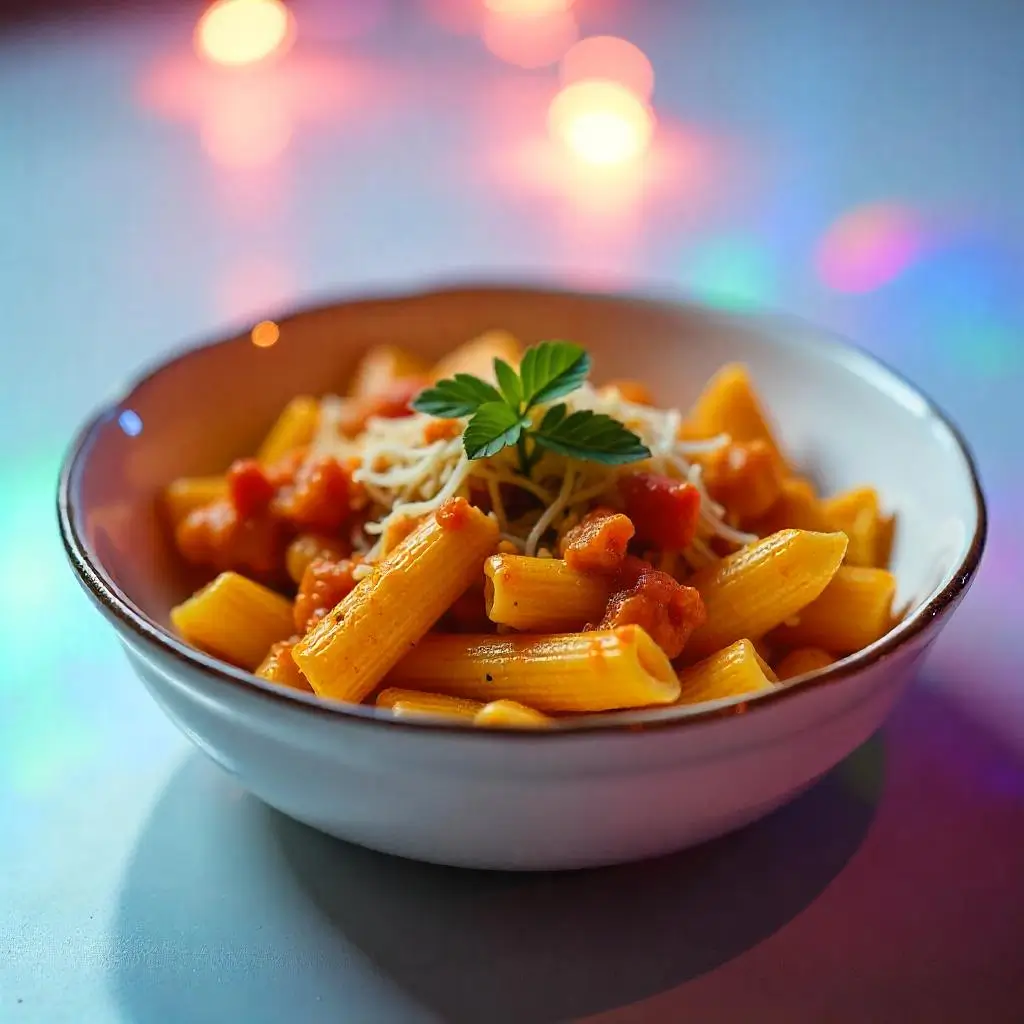
Storage and Reheating: Making the Most of Your Leftovers
Since this recipe creates 10-12 generous servings, proper storage techniques become essential for enjoying your baked ziti later.
Refrigerator Storage: After cooling completely, cover the dish tightly with aluminum foil or transfer portions to airtight containers. Subsequently, your baked ziti will stay fresh in the refrigerator for up to 5 days.
Reheating Methods: When ready to enjoy leftovers, you have two excellent options. First, oven reheating produces the best results by placing portions in a baking dish, covering with foil, and heating at 350°F for 20-30 minutes. Alternatively, microwave reheating works well for individual portions using 50% power for 1½-2 minutes, covered with parchment paper or damp paper towel.
Freezing Instructions: Furthermore, this dish freezes beautifully for up to 3 months. Simply cut into portions, wrap individually in plastic wrap, then store in freezer bags. Later, thaw overnight in the refrigerator before reheating using either method above.
Perfect Pairings: What to Serve Alongside Your Baked Ziti
While baked ziti is satisfying on its own, the right accompaniments can elevate your meal to restaurant quality. Most notably, fresh bread provides the perfect vehicle for soaking up any extra sauce. Consider serving semolina bread, crusty Dutch oven bread, or soft challah rolls for a complete dining experience.
Additionally, a simple green salad with Italian dressing cuts through the richness beautifully. Similarly, roasted vegetables like zucchini, bell peppers, or broccoli add color and nutrition to your plate.
Frequently Asked Questions About Baked Ziti
Can I make this recipe vegan? Absolutely! Simply substitute all dairy cheeses with vegan alternatives, omit the egg or use a flax egg replacement, and ensure your sauce contains no animal products.
What about gluten-free options? Certainly! Just replace regular pasta with your favorite gluten-free variety. The cooking method remains exactly the same.
Should I cover the dish while baking? Indeed, covering for the first 30 minutes prevents the top from browning too quickly. Then, removing the cover allows the cheese to achieve that perfect golden color.
How do I prevent the dish from drying out? Most importantly, ensure all pasta pieces are well-coated with sauce before baking. Additionally, when reheating, add extra sauce if the dish appears dry.
This incredible baked ziti recipe proves that sometimes the most satisfying meals come from the simplest ingredients. Furthermore, its make-ahead friendly nature and generous portions make it perfect for busy families. Whether you’re cooking for tonight’s dinner or planning ahead for the week, this comforting dish delivers every single time.
Baked Ziti vs Lasagna: Understanding the Delicious Difference
While both dishes are beloved Italian-American classics, there are some key distinctions worth noting. First and foremost, both recipes share similar foundational ingredients. Specifically, they both feature pasta, rich tomato sauce, and a heavenly blend of cheeses including ricotta, mozzarella, and parmesan. Additionally, most traditional versions include a beaten egg to bind the cheese mixture together.
However, the main difference lies in their construction method. On one hand, lasagna requires careful layering of flat pasta sheets with sauce and cheese between each layer. On the other hand, baked ziti takes a more relaxed approach by simply mixing everything together before baking. Consequently, this makes baked ziti significantly easier and faster to prepare, especially for busy weeknight cooking.
Furthermore, both dishes typically bake in a standard 9×13 inch dish, making them perfect for feeding larger families or meal prepping. Nevertheless, this particular recipe omits meat, creating a vegetarian-friendly option that doesn’t sacrifice any flavor or satisfaction.
Other recipe :
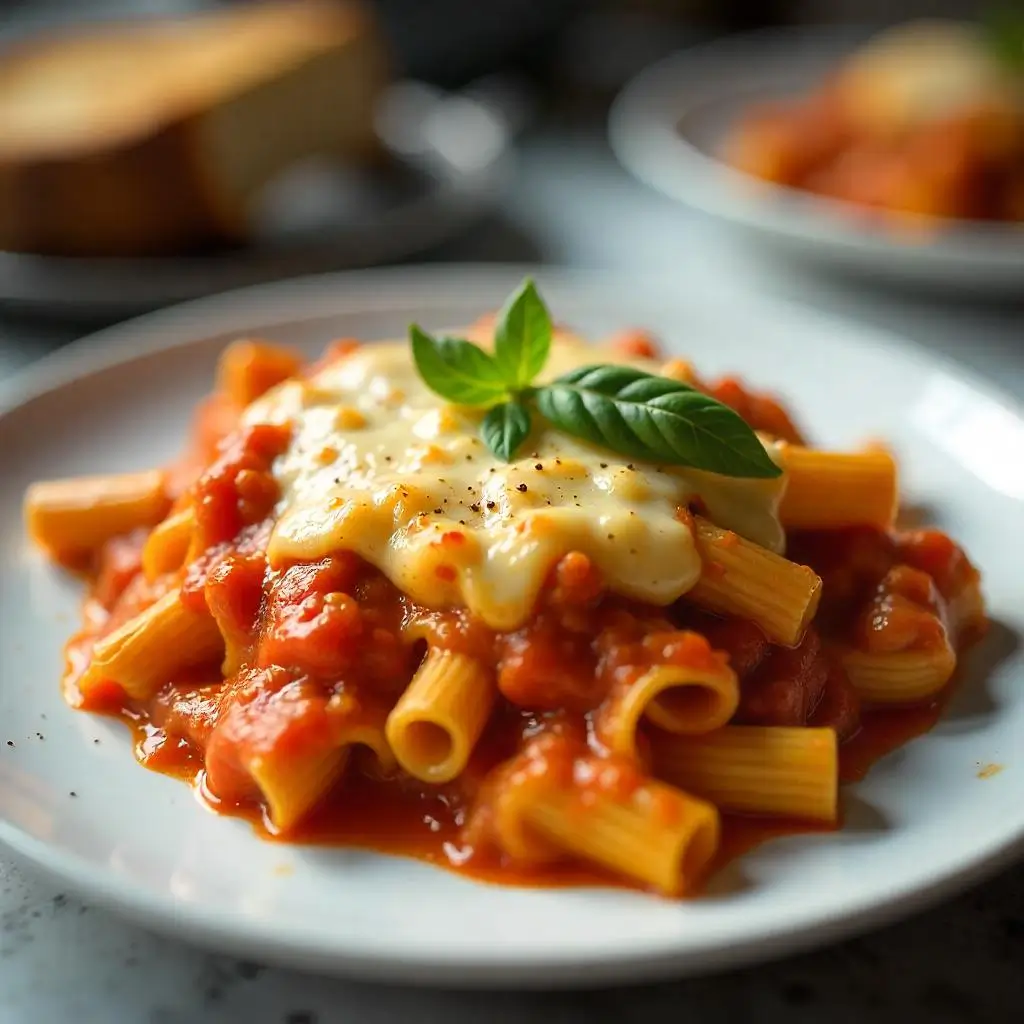
This ultimate baked ziti recipe represents everything wonderful about comfort food cooking. Most importantly, it transforms simple, affordable ingredients into something truly spectacular that brings families together around the dinner table. Furthermore, its forgiving nature means even novice cooks can achieve restaurant-quality results with confidence.
Additionally, the make-ahead friendly characteristics solve the eternal weeknight dinner dilemma. Consequently, busy parents can prepare this dish during weekend meal prep, then simply pop it in the oven after long workdays. Moreover, the generous yield ensures everyone gets fed while providing delicious leftovers for lunch the next day.
Beyond convenience, this recipe creates lasting memories. Indeed, there’s something magical about sharing a homemade meal that required time, care, and love to prepare. Subsequently, children grow up associating these flavors with family gatherings and special occasions.
Finally, mastering this classic opens doors to countless variations and improvements. Therefore, consider this your foundation recipe – one that will serve your family for years to come. Whether you stick to the traditional version or experiment with creative additions, you now possess the knowledge and techniques needed for baked ziti perfection every single time.
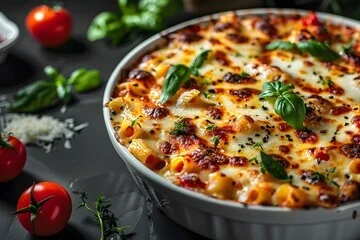
“How to Make Baked Ziti No Meat: A Simple and Savory Meatless Recipe”
Description
Learn how to make baked ziti with no meat! This simple, savory recipe is perfect for a hearty vegetarian dinner the whole family will love.
Ingredients
Ingredients
Instructions
- Prepare Pasta
- Cook ziti according to package directions minus 2-3 minutes for al dente texture. Drain and set aside.
- Mix & Preheat
- Preheat oven to 350°F (175°C). In a large bowl, combine ricotta, beaten egg, Parmesan, half the mozzarella, and spaghetti sauce. Season with salt and pepper.
- Combine
- Add drained pasta to cheese mixture and stir until well coated with sauce and cheese.
- Assemble
- Transfer mixture to greased 9×13 inch baking dish. Top with remaining mozzarella and extra Parmesan cheese.
- Bake
- Cover with foil and bake 30 minutes. Remove foil and bake additional 10-15 minutes until bubbly and golden brown.
- Rest & Serve
- Let stand 10-15 minutes before serving to allow cheese to set properly.
Instructions
Notes
- This baked ziti recipe is completely meatless but still packed with bold Italian flavor, thanks to a rich tomato sauce, creamy ricotta, and melty mozzarella. It’s perfect for vegetarians or anyone looking to enjoy a hearty comfort dish without meat. Feel free to add your favorite veggies like spinach, mushrooms, or zucchini for extra nutrition and texture. Great for meal prep, potlucks, or a cozy family dinner.
